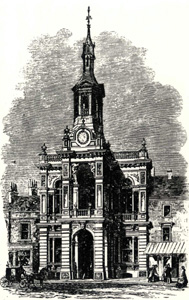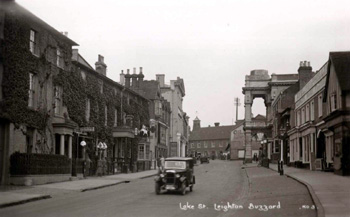The George and Dragon Leighton Buzzard

The Corn Exchange - site of the George and Dragon - in an Illustrated London News engraving of 1863
The George and Dragon Public House: 9 Lake Street, Leighton Buzzard [earlier The George]
The Manor of Leighton Buzzard alias Grovebury was the principal landowner in the town before the 19th century. Bedfordshire & Luton Archives & Records Service has a full run of court rolls from 1393 to 1727 [KK619-715] and another full run from 1704 to 1867 [X288/1-23]. The service also has court rolls for other manor to own land in the town, the Prebendal Manor, from 1448 to 1459, 1588 to 1591, 1611 to 1622, 1627 and 1631 [KK792-1798]. Detailed study of these would be bound to produce quite full histories for most licensed premises in the town. Unfortunately such study would take a very long time. Thus the histories of licensed premises in these web pages are quite summary and not necessarily the full story.
Maureen Brown, June Masters and Tom Lawson wrote a book called The Old Pubs of Leighton Buzzard and Linslade which was published by Leighton Linslade Local History Research Group in 1994. In producing the book they used sources at Bedfordshire & Luton Archives & Records Service, Buckinghamshire Record Office, Northamptonshire Record Office as well as a number of published sources. In notes lent to Bedfordshire and Luton Archives and Records Service, maureen Brown states that Charles Pym was admitted to the Cock in 1672 on surrender of William Pym.
In 1705 the copyhold inn called the George was surrendered by Charles and Sara Pym to the occupier Andrew Gladman [X288/1]. Gladman and his wife Sarah surrendered the inn along with two acres called Home Close to Peter Harding of Leighton Buzzard, hatter in 1719 [X288/3], Harding being admitted at the Manorial Court held the next year [X288/3]. Harding died in 1730 and his "infant" [i.e. not of age twenty one] grandson, Mark Fountaine, was duly admitted [X288/4]. In 1743 Fountaine sold the George to Peter Deverell, who was admitted the next year [X288/5].
In 1960 Bedfordshire Historical Records Society published a volume, its fortieth, dedicated to diaries. County Archivist Joyce Godber edited and published the diary of Leighton Buzzard Justice of the Peace John Salusbury (1713-1787) written between the years 1757 and 1759. He visited the George twice during the period of the diary, both times to meetings of his club, the Civil Society, on 19th January and 8th June 1758.
Bedfordshire & Luton Archives & Records Service has a formulary and notebook kept by 18th century attorney Benjamin Pyne which contains a list of twelve licensed properties in the town in 1761. Each inn also has a name beside it which appears to be the name of the licensee. The George is linked with the name of Edward Walker.
Thomas Deverell, the owner, died in 1765 and Thomas Deverell "an infant" was duly admitted [X288/7]. By 1791 the George was in the hands of Ann Kempster, widow of Capon Kempster [X288/9], the occupier was still Edward walker, though by 1793 he had moved to the Roebuck. In the Northampton Mercury of 19th January 1793 licensee of the George, John Procter, subscribed to a resolution of Leighton Buzzard publicans banning "seditious and disaffected persons" from their houses. This presumably was in reaction to the events across the Channel in France (four days previously King Louis XVI had been sentenced to death and two days later he went to the guillotine).
In 1798 William Sanders was admitted to a cottage called the George "wherein Giles Darling formerly dwelt, Edward Walker then since dwelt and John Procter then lately did dwell" [CCE2745]. Bedfordshire & Luton Archives & Records Service has a transcript [CRT130Lei5] which states: "In the Quarter Sessions Rolls for 1820 a pint pewter pot marked J. A. P. was found on the shelf of a man accused of theft. Joseph Procter gave evidence and said that the initials were those of his late cousin who had lived at the George Inn, Leighton Buzzard, and that pot belonged to William Saunders who had taken over the inn. Sophia Saunders said the pot had been lost from the inn about a month previously".
A later note reads "I hope the last paragraph is…corrupt as J. A. P. ought to stand for John and Ann Procter who were at the George Inn, Lake Street from about 1791-98 and died in 1829 and 1842 respectively". Sanders devised the George in his will of 1820 to his daughter Sophia; he died in 1823 and an inventory was taken of the George which read as follows [PLBP/W1823/20 - note the original spellings]:
- Kitchen or Tap Room: Kitchen range, smoak jack, chain, copper house boiler, fender, fire irons, steel footman, a 30 hour clock and case, long oak table, form and seat, salt box, small table, 5 chairs, 5 brass candlesticks, copper warming pot, coffee ditto, bacon rack and corner cupboard.
- Parlour: Two mahogany dining tables, 2 pillar and claw ditto, pier glass, 6 windsor chairs, 6 rush seated chairs, corner cupboard, pair window curtains, stove grate, fender, and sundry china.
- Back Kitchen: An old range, deal dresser and shelves, circular seat screen, ironing stove, windup jack, long oak table, 14 pewter dishes, 30 ditto plates, 3 spits, 2 holdfasts, 2 dripping pans, pair steelyards, pair bellows, 2 japanned tea trays, 3 ditto waiters, bread tray, knife ditto, 3 dozen knives and forks, 2 knife boxes, copper warming pan, 8 pewter quart measures, 16 pint ditto, tin can, lanthorn, oval copper boilers, 3 copper saucepans, salts, mustard, pepper and vinegar cruets, sundry coarse earthenware, 6 white oval dishes, 2 dozen plates, cheese toaster, tin ware, iron candlesticks, meat screen lined with tin, and 2 copper tea kettles.
- Dining Room: Four painted deal dining tables, pillar and claw table, 9 chairs, 2 window curtains, pier glass, tea tray, stone grate, fender and fire irons.
- Bed Room No. 1: Three half tester bedsteads and furniture, three feather beds, 3 bolsters and 6 pillows, six blankets, 2 quilts, 1 white cotton counterpane, 4 chairs, piece bedside carpet, small glass, 5 prints and pair oak drawers.
- Family Bed Room No. 2: four poster bedstead, check furniture, feather bed, bolster, 2 pillows, two blankets, quilt, small dressing table and glass, painted wash stand, basin drawer, white dimity window curtain, 3 chairs, 2 bedside carpets and pair drawers.
- Bed Room No. 3: four post bedstead, white furniture, feather bed, bolster and 2 pillows, 2 blankets, white cotton counterpane, press bedstead, feather bed, bolster and 2 pillows, two blankets, counterpane, 2 chairs, mahogany pillar and claw table, wash hand stand, basin and ewer, dressing table, window curtains and three pieces bedside carpet.
- Man Servant's Room: four half tester bedsteads and furniture, two flock beds, two feather beds and bolsters, eight blankets, 4 quilts, old table and form.
- Stair Case and Landing: Mahogany press bedstead, oval oak dining table, eight chairs, a 30 hour clock and case.
- Attic: two stump bedsteads, 2 feather beds and bolsters, two blankets, quilt, old chair, oak linen chest, piece matting, cloth flasket[?], oak linen chest, three bells.
- Ale Cellars: one ten hogshead cask, one six hogshead ditto, two four hogsheads, one working tub, seven iron bound pipes, three punchions, one hogshead, one working tub, small yest tub, three tap tubs, three brass taps, six barrel stands.
- Ale and Liquors: about twelve hogsheads of ale, eight gallons of gin, six gallons brandy, eight gallons rum.
- Brewhouse: 100 gallon brewing copper, grate and cover, mash tub, rule, set, funnel and bowl, underback, 2 coolers and stands, working tub, hop sieve, spout, washing copper and grate, frying pan, ladle, plate rack, 2 water pails, water tub, coal shoot and washing tray.
- Bar: three painted liquor casks and taps, slate, stone jars, pewter liquor measures, funnel, 28 glass rummers, 16 tumblers, 4 glass quart decanters, 3 pint ditto, one dozen wine glasses, two canisters, cruetstand.
- Linen and Plate: twelve pair sheets, 12 table cloaths, 8 pair pillow cases, 6 chamber towels and 8 round towels, six silver tea spoons, six table ditto, pair sugar tongs, silver pint, a tankard [as in CRT130Lei5 above?] and 2 punch ladles.
The valuation of all this was £191/15/6.
In 1952 Page Woodcock wrote for Volume III of the Bedfordshire Magazine (page 233): "In 1862, on ground where once stood the ancient corn market and a now-forgotten George and Dragon, the proud citizens erected their ornate Corn Exchange. It has had its day and the Atlases who support its high square arches are beginning to crumble. But beneath, a relic perhaps of the old George licence, is Mrs. Winifred Reynolds' bar, the Wine Lodge. According to Mr. Innes it has an 'on-and-off' licence, of which there are few left in the country. Apparently one can buy to absorb then and there, or to take away, or to re-sell (provided you have a licence). Like all bars it has its set of regulars".

Lake Street about 1930 [Z1306-72] following the truncation of the Corn Exchange tower
References:
- X288/1: surrender: 1705;
- HN2/PoF1: George noted as abuttal: 1714;
- X288/3: surrender: 1719;
- X288/3: admission: 1720;
- HN2/PoF4: George noted as abuttal in deeds: 1723;
- HN2/PoF11: George noted as abuttal in deeds: 1728;
- X288/4: admission of Mark Fountaine: 1730;
- HN2/PoF1: George noted as abuttal in deeds: 1731;
- X288/5: surrender: 1743;
- X288/5: admission: 1744;
- HN2/PoF19: George noted as abuttal in deeds: 1752;
- X171/206: landlord named: 1761;
- X288/7: death of Thomas Deverell: 1765;
- X288/7: admission: 1765;
- X288/9: admission: 1791;
- Northampton Mercury: resolution of Leighton Buzzard publicans banning "seditious and disaffected persons" from their houses: 19 Jan 1793;
- CCE2745: admission: 1798;
- CRT130Lei5: All Saints’ vestry meeting held at the George: 1799;
- HN2/PoF31: George noted as abuttal in deeds: 1802;
- BO171: bill for beer, suppers, punch and tobacco at George: 1817;
- CLP13: Register of alehouse licences: 1822-1828;
- PLBP/W1823/20: will of William Sanders and valuation of George Inn: 1820, proved 1823.
List of Licensees: note that this is not a complete list; entries in italics refer to licensees where either beginning or end, or both, dates are not known:
1705-1719: Andrew Gladman;
1719: Peter Harding;
some time between 1719 and 1744: William Hack;
some time between 1719 and 1744: William Farr;
1744: Giles Darling;
1746-1788: Edward Walker;
1790: Capon Kempster;
1791: Ann Kempster;
1793: John Procter;
1802-1823: William Sanders;
1823: Sophia Sanders;
1828-1850: Henry Hankin Franklin;
1853-1862: George Franklin
Public house closed and demolished in 1862 to make way for the Corn Exchange